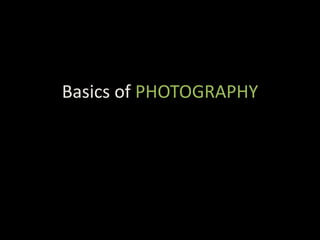
Understanding Exposure
- 2. Good Picture – Correct Exposure Aperture Controls the Amount of Light Entering the Camera Through the Aperture or the Iris of the Camera Lens and Falling on the Camera Sensor.
- 3. Good Picture – Correct Exposure Exposure Controlled by 3 Components Aperture Shutter Speed ISO
- 4. Good Picture – Correct Exposure Aperture The aperture of the camera behaves exactly in the same way the iris of our eyes do. When there is too much light the iris becomes SMALL or closes up When there is less light the iris enlarges or OPENS UP
- 5. Good Picture – Correct Exposure Aperture Very Sunny - Small iris – Higher the Number Low Light – iris opens up – Lower the Number
- 6. Composition/Framing – Depth of Field
- 7. Composition/Framing – Depth of Field • When the background is out of focus • For 2 reasons • The focus is on the object in the front • And the Aperture is fully open, ie the light is low or the light entering the camera is less because of the settings you have chosen.
- 8. Composition/Framing – Depth of Field
- 9. Depth Of Field F 22- Deep DoF F 4.2- Shallow DoF
- 10. Good Picture – Correct Exposure Shutter Speed The Speed at which the Shutter of the Camera Opens and Closes. It controls the amount of time the light gets to fall on/read by the sensor.
- 11. Good Picture – Correct Exposure Shutter Speed A High Shutter Speed is Used for Fast Moving Subjects/Objects
- 12. Good Picture – Correct Exposure High Shutter Speed A High Shutter Speed is Used for Fast Moving Subjects/Obj ects
- 13. Good Picture – Correct Exposure High Shutter Speed A High Shutter Speed is Used for Fast Moving Subjects/Obj ects
- 14. Good Picture – Correct Exposure Shutter Speed A Slow Shutter Speed is Used When the Light is LOW Or When a Blurry Effect is Desired
- 15. Good Picture – Correct Exposure Shutter Speed A Slow Shutter Speed is Used When the Light is LOW Or When a Blurry Effect is Desired
- 16. Good Picture – Correct Exposure Shutter Speed A Slow Shutter Speed is Used When the Light is LOW Or When a Blurry Effect is Desired
- 17. For Example – if you speed up your shutter speed one stop (from 1/125th to 1/250th) you’re effectively letting half as much light into your camera. To compensate for this, you’ll need to increase your aperture one stop (from F16 to F11). The other alternative would be to choose a more light sensitive ISO. Shutter Speed or any of the other variables of exposure cannot be used in isolation The 3 Elements of Exposure
- 18. Good Picture – Correct Exposure ISO ISO helps the camera Sensor to be more or less sensitive to light. Usually a Higher ISO is used when the Light is Low. Note – Higher the ISO, grainier the picture.
- 19. The 3 Elements of Exposure ISO
- 20. 100 ISO 3200 ISO The 3 Elements of Exposure ISO
- 21. The 3 Elements of Exposure ISO When Choosing the ISO setting ask yourself: 1. LIGHT – Is the subject well lit? 2. GRAIN – Do I want a grainy shot or one without noise? 3. TRIPOD – Am I using a tripod? 4. MOVING Subject – Is my subject moving or stationary? 1. If there is plenty of light, 2. I want little grain, 3. I’m using a tripod and 4. my subject is stationary – I will use a lowISO rating.
Editor's Notes
- What is ISO?– In film Photography, it is the indication of how sensitive a film is to light. You will see them on films (100,200,400,800 etc) The lower the number, the lower the sensitivity of the film and the finer grain in the shots. - In Digital Photography, it measures the sensitivity of the image sensor. The lower the number, the less sensitive your camera is to light and the finer the grain. Higher ISO settings are used in darker situations, however the cost is a noisier shot.
- 100 ISO – is generally accepted as ‘normal’ and will give you lovely crisp shots (little noise/grain) Most photographers tend to keep their digital cameras in ‘AUTO MODE’ where the camera selects the appropriate ISO setting depending upon the conditions you’re shooting in. Some cameras give you an opportunity to override the camera, and allow you to choose your own ISO. This will impact upon the aperture and the shutter speed needed for a well exposed shot. For example if you moved the ISO from a 100 to 400, you’ll notice that you can shoot at higher shutter speeds and/or smaller apertures.
- 100 ISO – is generally accepted as ‘normal’ and will give you lovely crisp shots (little noise/grain) Most photographers tend to keep their digital cameras in ‘AUTO MODE’ where the camera selects the appropriate ISO setting depending upon the conditions you’re shooting in. Some cameras give you an opportunity to override the camera, and allow you to choose your own ISO. This will impact upon the aperture and the shutter speed needed for a well exposed shot. For example if you moved the ISO from a 100 to 400, you’ll notice that you can shoot at higher shutter speeds and/or smaller apertures.